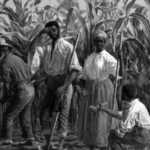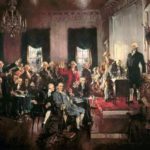When the delegates to the Philadelphia Convention convened in May of 1787 to recommend amendments to the Articles of Confederation, one of the first issues they addressed was the plan for representation in Congress. This lesson will focus on the various plans for representation debated during the Constitutional Convention of 1787.
Civic Art Projects: Seat at the Table Lesson Plan
This collaborative art project was inspired by Congresswoman Shirley Chisholm’s story and considers the importance of diverse representation in public discourse. This lesson plan is designed to help you facilitate the design and creation of your class’s chairs — your “seats at the table” of representative democracy.
James Madison and Proportional Representation

This short video highlights James Madison’s commitment to proportional representation in the newly-created Congress. However, he did not believe that the size of a state alone played an overly significant role in the decisions of either its citizens or its legislators. Professor Jack Rakove explains how Madison understood the various self-interests of all states and how he tried to account for this variation in crafting the new Constitution.
Slavery and the Three-Fifths Compromise

This short video explains the role played by slavery in counting population for taxation and representation. Drawing upon an unsuccessful 1783 amendment to the Articles, James Madison suggested that the slave population be counted at 60% for both representation and taxation. Professor John Kaminski explains how this “federal ratio” reconciled Southerners (who wanted slaves counted as people for representation) and Northerners (who wanted slaves counted as property in determining taxation.)
Civic Art Project: From Her Beacon
Students will work collaboratively to create a mural of the Statue of Liberty to show the statue as a representation of freedom and a symbol of welcome to immigrants coming from other countries. This lesson can be adapted for different grade levels. High school students will read a poem and incorporate some of its ideas into their mural. Elementary and middle school students will incorporate words and phrases inspired by the statue into their mural. This activity supports Art, Social Studies, Civics, and English Language Arts standards and can be used as a cross-curricular project across these classrooms. Teachers across the curricula are encouraged to work together to bring this activity to life.
Article I: The Legislative Branch
The power to make laws in our country falls in the hands of the Legislative Branch. The branch is outlined in Article I of the Constitution. The Legislative Branch is divided into two houses of Congress. The House of Representatives is made up of representatives proportionate to their state’s population while each state maintains equal representation in the Senate. Learn all about Article I in the National Constitution Center’s learning module.
The Constitutional Convention of 1787
In this unit, students will examine the roles that key American founders played in creating the Constitution, and the challenges they faced in the process. They will learn why many Americans in the 1780s believed that reforms to the Articles of Confederation were necessary, and the steps taken to authorize the 1787 Convention in Philadelphia. They will become familiar with the main issues that divided delegates at the Convention, particularly the questions of representation in Congress and the office of the presidency. Finally, they will see how a spirit of compromise, in the end, was necessary for the Convention to fulfill its task of improving the American political system.
Act II: What Was the Connecticut Compromise at the Constitutional Convention?

This short video explores the Connecticut Compromise, in which the delegates rejected an “either/or” solution to the question of representation and instead “thought out of the box,” creating a government that was partly national and partly federal. Professor Gordon Lloyd points out that although the final vote (5/4/1) on the Compromise did not reflect a bi-partisan consensus, it nevertheless was a significant breakthrough for moving on to other issues.
Senate Immersion Module Curriculum

The materials in this curriculum are designed to enhance the Institute’s immersive SIM experience. The SIM is an educational, game-like experience, developed to engage new generations of Americans. This program is conducted in the Institute’s full- scale representation of the United States Senate Chamber. Running with up to 100 students at a time, participants take on the roles of senators to learn about representation, study issues, debate, negotiate, and vote on legislation.
Immigration Reform (SIM Lesson Plans)

The purpose of this learning module is to help students learn how a U.S. Senator might address an issue of public significance under consideration in the United States Congress. Learning about personal, state, party, and national interests will help students understand representation more fully. The pre-visit examines how elected representation works. The post-visit lesson supports critical analysis of each student’s strategic choices and votes, preparing them to defend their efforts.
